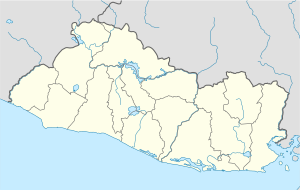San Isidro, Cabañas facts for kids
Quick facts for kids
San Isidro
|
|
|---|---|
|
Municipality
|
|
| Country | |
| Department | Cabañas Department |
| Area | |
| • Total | 30.24 sq mi (78.33 km2) |
| Elevation | 1,191 ft (363 m) |
| Population
(2006)
|
|
| • Total | 10,533 |
San Isidro is a town in El Salvador. It is located about 70 kilometers (43 miles) northeast of the capital city, San Salvador. This town is part of the Cabañas Department.
Contents
History of San Isidro
The area of San Isidro became a parish (a church district) on February 18, 1873. Before this, it was part of the San Vicente Department from 1824 until 1873. Then, it joined the new Cabañas Department.
On February 7, 1879, San Isidro officially became a municipality. This means it gained its own local government.
In 1977, an archaeologist named Wolfgang Haberland explored the area. He found ancient rock carvings, called petroglyphs, in the Grutas de Corinto caves. These carvings are very old, dating back to a time between 1200 and 400 BC.
Later, in the late 1990s, an organization called FAO helped San Isidro. They funded a project to teach farmers how to grow crops on hillsides in a way that protects the environment.
Geography of San Isidro
San Isidro covers an area of about 78.33 square kilometers (30.24 square miles). It shares its borders with several other towns. To the north and east, it borders Sensuntepeque. To the east, it borders Guacotecti.
To the south, San Isidro borders Santa Clara, San Esteban Catarina, and San Sebastián. These towns are in the San Vicente Department. To the west, it borders Ilobasco.
The municipality is surrounded by hills like Morontepeque, Humeras, and El Orégano. Several rivers flow through the area, including Las Cañas, De los Pueblos, Titihuapa, San Isidro, El Jícaro, and Viejo.
Administrative Divisions
San Isidro is divided into 7 main areas called cantons. These cantons are further split into 22 smaller villages, known as caseríos.
- Izcatal: This canton has 687 people and includes two villages: Izcatal and Las Vainillas.
- El Ámate: This is a larger canton with 1,402 people. It has five villages: El Ámate, El Zarzal, El Junquillo, and La Loma.
- Los Jobos: Home to 1,085 people, this canton has four villages: Los Jobos, Cerro de Ávila, Los Jobitos, and El Jute.
- Llano de La Hacienda: This canton has 1,424 people and one village, also called Llano de la Hacienda.
- Potrero de Batres: With 837 people, this canton includes two villages: Potrero de Batres and El Tablón.
- Potrero y Tabla: This canton has 557 people and two villages: Potrero y Tabla and Horcones.
- San Francisco: This canton has 1,397 people and includes three villages: San Francisco, Hacienda Vieja, and Las Minas.
Economy of San Isidro
The people of San Isidro mainly work in agriculture. They grow important crops like basic grains, sesame, and sugarcane. Farmers also raise animals such as cattle, pigs, horses, and mules.
Local businesses produce dairy products like milk and cheese. They also make sweet brown sugar. San Isidro is also known for making materials used in building.
A local group called the Asociacion de Amigos de San Isidro Cabanas (ASIC) works on issues related to mining in the area.
Landmarks in San Isidro
The main government building for the municipality is on Avenida Mayo 15. It was built in 1956. The building is made of adobe (a type of mud brick) with a tile roof and wooden frame. It has a colonial-style entrance. Over the years, this building has been used as the mayor's office, a place to hold people, and a health center.
The Casa de la Cultura (House of Culture) is on Calle Central. It has mud brick walls and strong concrete columns. It features glass windows and brick cement floors.
The Iglesia San Isidro Labrador is a church that was finished in 1988. It is an important religious building in the community.
See also
 In Spanish: San Isidro (Cabañas) para niños
In Spanish: San Isidro (Cabañas) para niños


